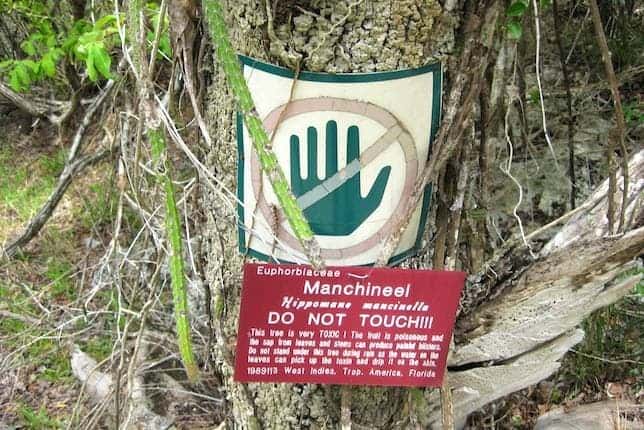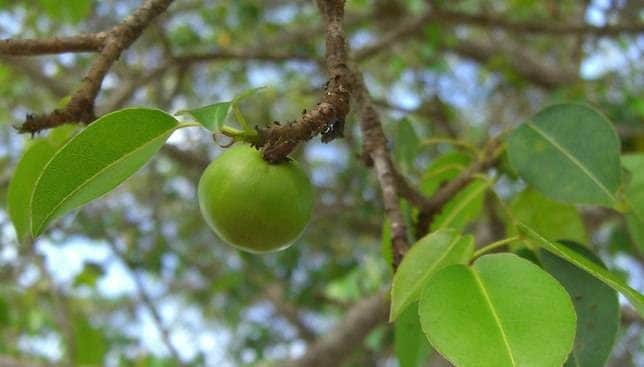
A vacation on a sunny island in the Caribbean could take a turn for the worse if you’re unfortunate enough to come across the manchineel. No, it’s not some drug trafficking gang nor some venomous creature. It’s a tree whose green fruits look a lot like crabapples. Munch them and you’ll get diarrhea and stomach burns faster than Eve got kicked out of Eden. Eat enough of the toxic fruit and you’ll die. The tree is so dangerous even standing beneath it on a rainy day could be fatal as the tree’s bark is laced with water soluble toxins.
This is where Snow White’s stepmother sources her goods
Locals where the manchineel tree (Hippomane mancinella) is native — places like South Florida, the Caribbean, Central American, and northern South America — have learned to keep away from it. They even gave it an ominous name in Spanish, arbol de la muerte, so people know they shouldn’t mess with it, which literally translates into “tree of death.”

If you’re strolling through some of the paradisiac places where the manchineel grows, you should likely see the trees marked with some danger signs or big painted red crosses as captioned above. Some trees may elude markings, though, which is why every year a select few get poisoned. It happened to Nicola Strickland and her friends in 1999 while vacationing in the Carribean. Attracted by colorful green fruits which looked like small apples, Strickland and gang took a few bites of the fruit. Not too long after their throats tightened to the point they could barely swallow anymore.
No one died that fateful day, though, since the group was lucky enough to ingest only a few bites. Strickland, who is a radiologist, published her experience in The British Medical Journal.
“I rashly took a bite from this fruit and found it pleasantly sweet. My friend also partook (at my suggestion). Moments later we noticed a strange peppery feeling in our mouths, which gradually progressed to a burning, tearing sensation and tightness of the throat. The symptoms worsened over a couple of hours until we could barely swallow solid food because of the excruciating pain and the feeling of a huge obstructing pharyngeal lump. Sadly, the pain was exacerbated by most alcoholic beverages, although mildly appeased by pina coladas, but more so by milk alone,” she wrote.
“Over the next eight hours our oral symptoms slowly began to subside, but our cervical lymph nodes became very tender and easily palpable. Recounting our experience to the locals elicited frank horror and incredulity, such was the fruit’s poisonous reputation.”
The medical problems are caused by the milky sap that oozes out of the tree. When coming in contact with the skin, it causes blistering, burns, and inflammation. Burned manchineel wood could also cause problems if the smoke gets in the eyes. According to a 1984 study, tigliane phorbol esters seem to be toxic compounds that cause these symptoms.
While the esters are found in high concentration in the green fruits, the whole tree packs the toxins — bark, leaves, fruits. Even if you don’t touch the tree itself, you run at risk of getting burned by the caustic esters if these are transported on your skin somehow, such as when it rains. In fact, this is how Calusa native North American fighters from Florida won against conquistador Juan Ponce de Leon and his expedition when they tried to conquer the peninsula in the 16th century. The natives made poisoned arrows out of the manchineel sap and one such arrow struck de Leon in the thigh. He retreated in Cuba where he later died from the toxins. Legend has it, also, that the natives would torture prisoners by placing them beneath the tree when it rains. The highly caustic water blinded the prisoners and caused terrible pain.
Seeing how the manchineel is so dangerous, why don’t we just destroy it? Ethics aside, the manchineel tree is actually useful. It provides windbreaking and protection against coastal erosion on Central American beaches. Carpenters have been using its prized wood for centuries to make furniture out of it, being careful to cut the bark and leave the wood in the sun until the toxins are neutralized. It also has medical properties, as it can treat edema in gum form, while dried fruits have been used as a diuretic — of course, you have to be very careful about it.
From an evolutionary perspective, it’s clear the manchineel adapted this trait for protection but it’s not clear what could have tempted it to go to such extreme. Being so poisonous, it can’t rely on animals to spread its seeds, which is a disadvantage, but it seems to make up for it by leaving in coastal areas where the wind can do the job.
It’s not so often that you hear about a killer tree, not unless you count crashing a car into one. We’re used to seeing trees as benign but the manchineel proves there’s more to it. So, next time you vacation in an exotic location, be sure to get all your shots and, most importantly, read about dangerous local fauna.






